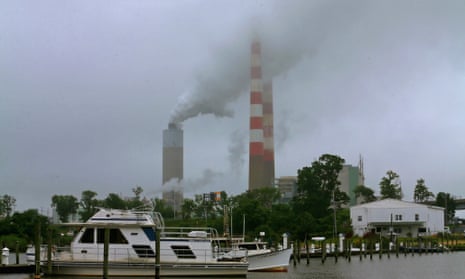Business lobbies and conservative thinktanks have carried out a series of pre-emptive strikes aimed at wrecking Monday's launch of Barack Obama's historic climate plan.
The new rules – the first to cut carbon pollution from power plants – will define Obama's environmental legacy and could break open negotiations for a global deal on climate change.
But well before their release, they set off duelling spin campaigns on the costs and benefits of the new rules, and their impact on climate change.
The new rules, which were written by the Environmental Protection Agency (EPA), will for the first time cut carbon pollution from the country's power plants – the single biggest source of carbon dioxide emissions that cause climate change.
The country's biggest business lobby, the Chamber of Commerce, got out in front, claiming the plan would cost the economy $51bn a year by 2030, and that 224,000 Americans would lose their jobs.
The chamber, a committed opponent of Obama and any curbs on pollution, said the burden of the new rules would fall heaviest on south-eastern states which are heavily dependent on coal, and not as well-suited for wind or hydro power as other regions.
The coal lobby – which had more apocalyptic economic forecasts – said the rules would have no effect on climate change. “Even if our nation’s entire coal fleet was shut down, global emissions of greenhouse gases would be reduced by just 3%,” Mike Duncan, the president of the American Coalition for Clean Coal Electricity wrote in a blogpost on Friday.
The chamber said the EPA plan would cut global emissions by just 1.8%, while the Cato Institute, which was founded by the conservative oil billionaire Koch brothers, said the new rules would reduce warming by an even more miniscule 0.018%.
Joe Manchin, a Democratic senator from the coal state of West Virginia, said the new rules would not just hurt the economy – they would kill people outright. "A lot of people on the lower end of the socio-economic spectrum [are] going to die,” he said earlier this month.
As expected, the view from the opposite side of the political spectrum is decidedly different.
The Natural Resources Defense Council, which produced the model plan that served as a guideline for the EPA regulations, said cutting carbon pollution from power plans would save Americans $37.4 bn on their electricity bills in 2020.
It would create more than 274,000 jobs for roofers and electricians installing solar panels and new energy-saving technologies, the analysis said.
The NRDC said the plan could cut carbon pollution by about 35% from 2005 levels, or the equivalent of up to 700m tons.
The Union of Concerned Scientists, the Clean Air Task Force and the Environmental Defense Fund have also put out reports arguing that the climate plan is relatively affordable, and would produce widespread benefits.
So who is right?
The White House criticised the chamber's projections as “doomsday claims”.
The New York Times' Paul Krugman wrote on Thursday that $50bn was a pretty good deal. “So, is $50bn a lot? Let’s look at the CBO’s long-term projections. These say that average annual US real GDP over the period 2014-2030 will be $21.5tn. So the chamber is telling us that we can achieve major reductions in greenhouse gases at a cost of 0.2% of GDP. That’s cheap!”
He said the chamber's estimate for job losses was also a small number for a workforce of 140 million.
Brian Murray, director of economic analysis at Duke University's Nicholas Institute, said it was impossible to gauge the full economic impact of the new rules before their release.
But he suggested it might make sense to look at both studies as outliers. “I wouldn’t conclude one is more biased than the other,” he said in an email. “It may be reasonable to view these as upper and lower bounds of economic impact. “
The EPA said any costs to power companies of the new rules should be weighed against the far greater risks of not dealing with the threat of climate change. “The cost of inaction on climate is a real drain on our economy,” the agency said.
Researchers at Harvard and Syracuse universities said this week the new rules could produce significant public health benefits – if they were stringent enough. The researchers said steep cuts in carbon pollution would also deliver reductions of mercury and other pollutants,.
That would avoid tens of thousands of premature deaths from heart attacks, lung cancer, and asthma, the report said. It put the annual public health savings at $280bn.






Comments (…)
Sign in or create your Guardian account to join the discussion